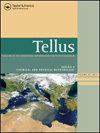飞机排放NOx对对流层臭氧变化的闪电和对流影响
IF 2.3
4区 地球科学
Q3 METEOROLOGY & ATMOSPHERIC SCIENCES
Tellus Series B-Chemical and Physical Meteorology
Pub Date : 1999-09-01
DOI:10.3402/TELLUSB.V51I4.16484
引用次数: 60
摘要
一个全球三维化学示踪模型(CTM)已被用于计算当今亚音速飞机机队排放的nox对对流层臭氧造成的影响(0.52 Tg(N)/年)。由于闪电和深对流作为对流层上层nox来源的不确定性,臭氧扰动的强度和分布的不确定性已经得到了研究。已经进行了三组两组CTM实验,有和没有飞机的排放。一个参考集有正常对流和雷电12 Tg(N)/ yr,一个集有减少的雷源(5 Tg(N)/ yr),一个集有减少的对流活动(空气质量通量降低67%)。在参考情况下,对流层上层臭氧在40°N以北的纬向均匀增加,在5月份达到最大值5-6 ppbv。闪电减少nox排放的最大影响是夏季北部中高纬度地区的飞机使臭氧增强50-70%。这是由于氮氧化物本底浓度较低,因此臭氧产生效率较高。对流混合的减少导致中纬度北部飞机诱发臭氧增加40%,热带地区增加150%。在这种情况下,对流层上层的背景nox水平较高,导致飞机产生nox的臭氧效率降低。然而,飞机排放物产生的臭氧向下混合减少,足以弥补这一损失。DOI: 10.1034 / j.1600 0889.1999.t01 - 3 - 00003. x本文章由计算机程序翻译,如有差异,请以英文原文为准。
Effects of lightning and convection on changes in tropospheric ozone due to NOx emissions from aircraft
A global 3-dimensional chemical tracer model (CTM) has been used to calculate the impact on tropospheric ozone caused by NO x emissions from today's fleet of subsonic aircraft (0.52 Tg(N)/ yr). Uncertainties in the magnitude and distribution in the ozone perturbation due to uncertainties in lightning and deep convection as sources of upper tropospheric NO x have been studied. Three sets of two CTM experiments have been performed, with and without emissions from aircraft. A reference set with normal convection and 12 Tg(N)/ yr from lightning, a set with reduced lightning source (5 Tg(N)/ yr), and one set with reduced convective activity (67% lower mass fluxes of air). A zonally homogeneous increase in upper tropospheric ozone north of 40°N, reaching a maximum of 5–6 ppbv during May was found in the reference case. The largest effect of lower NO x emissions from lightning was a 50–70% higher enhancement of ozone due to aircraft at northern mid- and high-latitudes during summer. This was caused by lower background concentrations of NO x and therefore more effcient ozone production. Reduced convective mixing lead to a 40% increased enhancement in aircraft induced ozone at northern mid-latitudes and 150% enhancement in the tropics. In this case background NO x levels were higher in the upper troposphere, giving a decreased ozone production efficiency of NO x from aircraft. This was however, more than compensated for by a decreased downward mixing of ozone produced by emissions from aircraft. DOI: 10.1034/j.1600-0889.1999.t01-3-00003.x
求助全文
通过发布文献求助,成功后即可免费获取论文全文。
去求助
来源期刊
自引率
0.00%
发文量
3
期刊介绍:
Tellus B: Chemical and Physical Meteorology along with its sister journal Tellus A: Dynamic Meteorology and Oceanography, are the international, peer-reviewed journals of the International Meteorological Institute in Stockholm, an independent non-for-profit body integrated into the Department of Meteorology at the Faculty of Sciences of Stockholm University, Sweden. Aiming to promote the exchange of knowledge about meteorology from across a range of scientific sub-disciplines, the two journals serve an international community of researchers, policy makers, managers, media and the general public.

 求助内容:
求助内容: 应助结果提醒方式:
应助结果提醒方式:


